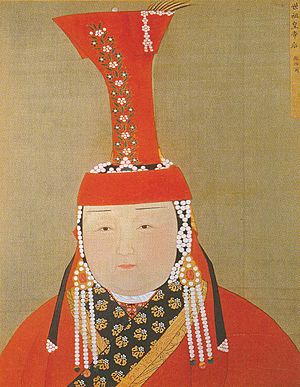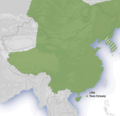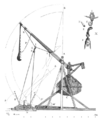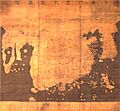Kublai Khan facts for kids
Quick facts for kids Kublai Setsen KhanEmperor Shizu of Yuan |
|
|---|---|
|
|
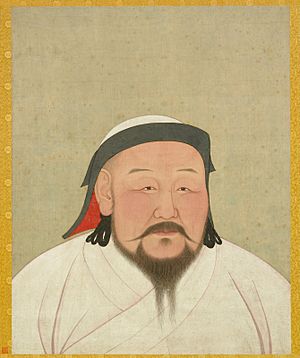
Portrait of Kublai Khan
|
|
| 5th Khagan of the Mongol Empire | |
| Reign | 5 May 1260 – 18 February 1294 |
| Coronation | 5 May 1260 |
| Predecessor | Möngke Khan |
| Successor | Temür Khan (Yuan dynasty) |
| 1st Emperor of the Yuan dynasty | |
| Reign | 18 December 1271 – 18 February 1294 |
| Successor | Temür Khan |
| Born | 23 September 1215 Mongol Empire |
| Died | 18 February 1294 (aged 78) Khanbaliq, Yuan dynasty, China |
| Burial | Burkhan Khaldun (now Khentii Province, Mongolia) |
| Religion | Tibetan Buddhism |
Kublai was the fifth Khagan (Great Khan) of the Mongol Empire, reigning from 1260 to 1294. He also founded the Yuan dynasty in China as a conquest dynasty in 1271, and ruled as the first Yuan emperor until his death in 1294.
Kublai was the fourth son of Tolui and a grandson of Genghis Khan. He succeeded his older brother as Khagan in 1260, but had to defeat his younger brother in the Toluid Civil War lasting until 1264. This episode marked the beginning of disunity in the empire.
Kublai's seizure of power in 1260 pushed the Mongol Empire into a new direction. Despite his controversial election, which increased the conflict with Mongols, Kublai's willingness to formalize the Mongol realm's joint relations with China brought the Mongol Empire to international attention. Kublai and his predecessors conquests were largely responsible for re-creating a unified powerful China.
Kublai's real power was limited to China and Mongolia, though as Khagan he still had influence in the Ilkhanate and to a lesser degree, in the Golden Horde. If one counts the Mongol Empire at that time as a whole, his realm reached from the Pacific Ocean to the Black Sea, from Siberia to what is now Afghanistan.
In 1271, Kublai established the Yuan dynasty, which ruled over present-day Mongolia, China, Korea, and some adjacent areas, and assumed the role of Emperor of China. By 1279, the Mongol conquest of the Song dynasty was completed and Kublai became the first non-Han emperor to conquer all of China.
Kublai wrote many pages of Chinese poetry, though most of his works have not survived.
He succeeded in building a powerful empire, created an academy, offices, trade ports and canals and sponsored science and the arts. The record of the Mongols lists 20,166 public schools created during Kublai's reign.
Kublai promoted economic growth by rebuilding the Grand Canal, repairing public buildings, and extending highways. Kublai encouraged Asian arts and demonstrated religious tolerance.
Muslim scholars, scientists and astronomers contributed to the construction of the observatory in Shaanxi. Astronomers such introduced 7 new instruments and concepts that allowed the correction of the Chinese calendar.
Muslim mathematicians introduced Euclidean Geometry, spherical trigonometry and arabic numerals in China, cartographers made accurate maps of all the nations along the Silk Road and greatly influenced the knowledge of Yuan dynasty rulers and merchants.
The imperial portrait of Kublai was part of an album of the portraits of Yuan emperors and empresses, now in the collection of the National Palace Museum in Taipei.
White, the color of the royal costume of Kublai, was the imperial color of the Yuan dynasty.
Kublai became increasingly despondent after the deaths of his favorite wife and his chosen heir Zhenjin. The failure of the military campaigns in Vietnam and Japan also haunted him. Kublai turned to food for comfort, became grossly overweight, and suffered gout and diabetes. Kublai tried every medical treatment available, from Korean shamans to Vietnamese doctors, and remedies and medicines, but to no avail. At the end of 1293, the emperor refused to participate in the traditional New Years' ceremony. Before his death, Kublai passed the seal of Crown Prince to Zhenjin's son Temür, who would become the next Khagan of the Mongol Empire and the second ruler of the Yuan dynasty. Kublai weakened steadily, and on February 18, 1294, he died at the age of 78. Two days later, the funeral cortège took his body to the burial place of the khans in Mongolia.
Family
Kublai first married Tegulen but she died very early. Then he married Chabi of the Khongirad, who was his most beloved empress. After Chabi's death in 1281, Kublai married Chabi's young cousin, Nambui, presumably in accordance with Chabi's wish.
Principal wives (first and second ordos):
- Tegülün Khatun (d. 1233) — daughter of Tuolian of Khongirad. She married Kublai in 1232 but died shortly after giving birth.
- Dorji (b. c. 1233, d. 1263) — the director of the Secretariat and head of the Bureau of Military Affairs from 1261, but was sickly and died young.
- Empress Chabi (b. 1216, m. 1234, d. 1281) — daughter of Chigu Noyan from Khongirad. They had four sons and six daughters.
- Grand Princess of Zhao, Yuelie (赵国大長公主) — married to Ay Buqa, Prince of Zhao (趙王).
- Princess Ulujin (吾魯真公主) — married to Buqa from Ikires clan.
- Princess Chalun (昌国大长公主) — married to Teliqian from Ikires clan.
- Crown Prince Zhenjin (1240–1285) — Prince of Yan (燕王).
- Manggala (c. 1242–1280) — Prince of Anxi (安西王).
- Grand Princess of Lu, Öljei (鲁国长公主) — married to Ulujin Küregen from Khongirad clan, Prince of Lu.
- Nomughan (d. 1301) — Prince of Beiping (北平王).
- Grand Princess of Lu, Nangiajin (鲁国大长公主) — married to Ulujin Küregen from Khongirad clan, Princess of Lu, then after Ulujin's death in 1278 to his brother Temür, and after Temür's death in 1290 to a third brother, Manzitai.
- Kokechi (d.1271) — Prince of Yunnan.
- Princess Jeguk (1251–1297)
- Empress Nambui (m. 1283 – went missing 1290) — daughter of Nachen, who was the uncle of Empress Chabi.
- Temuchi
Wives from third ordo:
- Empress Talahai (塔剌海皇后 [zh])
- Empress Nuhan (奴罕皇后 [zh])
Wives from fourth ordo:
- Empress Bayaujin (伯要兀真皇后 [zh]) — daughter of Boraqchin of Bayauts.
- Toghon — Prince of Zhennan (鎮南王)
- Empress Kökelün (阔阔伦皇后 [zh])
Images for kids
-
Extract of the letter of Arghun to Philip IV of France, in the Mongolian script, dated 1289. French National Archives.
-
The "Muslim trebuchet" (or Huihui Pao) used to breach the walls of Fancheng and Xiangyang.
-
Two dragons chasing a flaming pearl was a symbol associated with Goryeo.
-
The Gangnido reflects the Chinese geographical knowledge during the Mongol Empire about countries in the West.
-
Japanese samurai boarding Yuan ships in 1281.
-
Kublai gives financial support to the Polo family.
-
Rabban Bar Sauma, ambassador of Great Khan Kublai and Ilkhan Arghun, travelled from Dadu to Rome, Tuscany, Genoa, Paris, and Bordeaux to meet with European rulers in 1287–88.
-
The White Stupa of Dadu (or Khanbaliq; now Beijing).
-
A Yuan dynasty jade belt plaque featuring carved designs of the Azure Dragon, highly regarded as a symbol of Yuan China's maritime strength.
-
Longevity Hill in Beijing, where Kublai Khan wrote his poem.
-
Statue of Kublai Khan in Sükhbaatar Square, Ulaanbaatar. Together with Ögedei Khan's, and the much larger Genghis Khan's statues, it forms a statue complex dedicated to the Mongol Empire.
See also
 In Spanish: Kublai Kan para niños
In Spanish: Kublai Kan para niños



